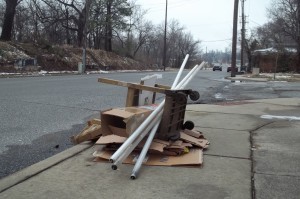Both large quantity handlers and small quantity handlers of universal waste are required to identify the universal waste by one of three options:
- Universal Waste…
- Waste…
- Used…
The name of the universal waste that follows will depend on its type. The USEPA identifies four universal waste categories, they are:
- Lamps
- Batteries
- Mercury Containing Devices
- Recalled or Cancelled Pesticides
|
Daniels Training Services 815.821.1550 |
The labeling requirements of the first three are relatively simple (eg. “Waste Batteries” or “Universal Waste Lamps” or “Used Mercury Containing Devices” &etc.). The labeling of Recalled or Cancelled Pesticides is more challenging, if interested I recommend you read: Identification and Management of Universal Waste (slides 50-56).
Many states have added to this list of universal wastes, however I have found the labeling requirements to remain the same as these. Please check with your state to be sure.
You can be sure that the following examples are all a violation of Federal and State regulations:
- “Bad Batteries”
- “Spent Lamps”
- “Batteries for Recycling”
- And any other that isn’t one of the allowed options.
Since universal wastes have an on-site accumulation time limit of one year – and perhaps longer if necessary to facilitate disposal, confirm this with your state – you must indicate the date of initial accumulation in order to demonstrate the amount of time the universal waste has been on-site.
So, that’s two things that must be communicated:
- The name of the universal waste.
- Its date of initial accumulation.
The question remains, “How?”
Answering that question is the purpose of this article.
The regulations pertaining to communicating the name of the universal waste are relatively straight forward:
40 CFR 273.14 Labeling/marking
A small quantity handler of universal waste must label or mark the universal waste to identify the type of universal waste as specified below:
(a) Universal waste batteries (i.e., each battery), or a container in which the batteries are contained, must be labeled or marked…
(b) A container, (or multiple container package unit), tank, transport vehicle or vessel in which recalled universal waste pesticides…
(c) A container, tank, or transport vehicle or vessel in which unused pesticide products as described in 40 CFR 273.3(a)(2) are contained must be labeled or marked clearly…
(d)(1) Universal waste mercury-containing equipment (i.e., each device), or a container in which the equipment is contained, must be labeled or marked clearly…
(2) A universal waste mercury-containing thermostat or container containing only universal waste mercury-containing thermostats may be labeled or marked clearly…
(e) Each lamp or a container or package in which such lamps are contained must be labeled or marked clearly…
The labeling and marking requirements for a large quantity handler of universal waste at 40 CFR 273.34 are exactly the same as those for a small quantity handler listed above.
It’s clear that no matter the type of universal waste, its identification by name – in one of the three approved forms – must be on each item (ie. battery, device, or lamp) or on the container, tank, transport vehicle, or vessel that holds it.
Communicating the date of initial on-site accumulation is more complicated.

Batteries, Lamps, Mercury Containing Devices, Recalled or Cancelled Pesticides…Does your State have any more?
40 CFR 273.15 Accumulation time limits
(c) A small quantity handler of universal waste who accumulates universal waste must be able to demonstrate the length of time that the universal waste has been accumulated from the date it becomes a waste or is received. The handler may make this demonstration by:
(1) Placing the universal waste in a container and marking or labeling the container with the earliest date that any universal waste in the container became a waste or was received;
(2) Marking or labeling each individual item of universal waste (e.g., each battery or thermostat) with the date it became a waste or was received;
(3) Maintaining an inventory system on-site that identifies the date each universal waste became a waste or was received;
(4) Maintaining an inventory system on-site that identifies the earliest date that any universal waste in a group of universal waste items or a group of containers of universal waste became a waste or was received;
(5) Placing the universal waste in a specific accumulation area and identifying the earliest date that any universal waste in the area became a waste or was received; or
(6) Any other method which clearly demonstrates the length of time that the universal waste has been accumulated from the date it becomes a waste or is received.
Again, the requirements for a large quantity handler of universal waste (at 40 CFR 273.35) are exactly the same as those of a small quantity handler identified above.
|
Like this article? Subscribe to my Monthly Newsletter No marketing emails! |
So, a handler of universal waste can choose from one of the following options to indicate how long its universal waste has accumulated on-site:
- Mark or label the container with the date of initial accumulation.
- Mark or label each individual item (ie. battery, device, or lamp).
- Maintain an inventory system that indicates the date of waste generation or receipt.
- For each individual item, or;
- The earliest date for an entire group.
- Create an accumulation area for the universal waste and indicate the earliest date that any waste in the area was received or became a waste.
- Any other method that clearly demonstrates the amount of time the universal waste has accumulated on-site.
In sum, while the name of the universal waste must be labeled or marked on the item or container (no area signs will do) there is much more flexibility for indicating the amount of time the universal waste has accumulated on-site.
If you generate any hazardous waste or universal waste you will benefit from one of my training services. Contact me for a free consultation to determine just what training you need to ensure compliance with Federal and State regulations.
|
Training Services I provide for HazMat Employees & Hazardous Waste Personnel: |

